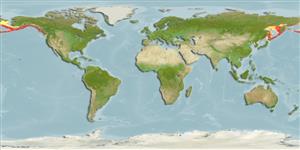Environment: milieu / climate zone / depth range / distribution range
Écologie
marin démersal; profondeur 25 - 770 m (Ref. 6793). Temperate
North Pacific: eastern Sea of Okhotsk to Cape Navarin in the Bering Sea to Agattu Island in the Aleutian chain and Vancouver Island, British Columbia, Canada.
Taille / Poids / Âge
Maturity: Lm ? range ? - ? cm
Max length : 24.0 cm TL mâle / non sexé; (Ref. 56391)
Épines dorsales (Total): 8 - 9; Rayons mous dorsaux (Total): 20-21; Épines anales 0; Rayons mous anaux: 15 - 17. Caudal fin rounded; pectoral fins rounded, reaching anus, lower rays exserted (Ref. 6885). Color brownish on upper surface, paler below; four dark saddles across back; dark bands on dorsal, caudal, and pectoral fins, the other fins are plain (Ref. 6885).
Life cycle and mating behavior
Maturité | Reproduction | Frai | Œufs | Fécondité | Larves
Eschmeyer, W.N., E.S. Herald and H. Hammann, 1983. A field guide to Pacific coast fishes of North America. Boston (MA, USA): Houghton Mifflin Company. xii+336 p. (Ref. 2850)
Statut dans la liste rouge de l'IUCN (Ref. 130435)
Menace pour l'homme
Harmless
Utilisations par l'homme
Plus d'informations
RéférencesAquacultureProfil d'aquacultureSouchesGénétiqueElectrophoresesHéritabilitéPathologiesTraitementNutrientsMass conversion
CollaborateursImagesStamps, Coins Misc.SonsCiguateraVitesseType de nageSurface branchialeOtolithesCerveauxVision
Outils
Articles particuliers
Télécharger en XML
Sources Internet
Estimates based on models
Preferred temperature (Ref.
123201): 0.7 - 6.3, mean 3.4 °C (based on 317 cells).
Phylogenetic diversity index (Ref.
82804): PD
50 = 0.5000 [Uniqueness, from 0.5 = low to 2.0 = high].
Bayesian length-weight: a=0.00646 (0.00406 - 0.01028), b=3.09 (2.95 - 3.23), in cm total length, based on LWR estimates for this species & (Sub)family-body (Ref.
93245).
Niveau trophique (Ref.
69278): 3.6 ±0.4 se; based on diet studies.
Generation time: 8.5 ( na - na) years. Estimated as median ln(3)/K based on 2
growth studies.
Résilience (Ref.
120179): Faible, temps minimum de doublement de population : 4,5 à 14 années (Preliminary K or Fecundity.).
Fishing Vulnerability (Ref.
59153): Moderate to high vulnerability (50 of 100).
